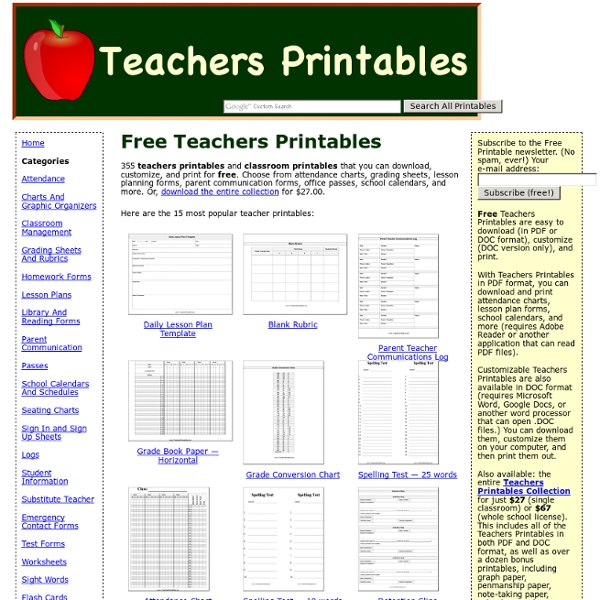



http://www.teachersprintables.net/
My Teacher Motivation Page #1 Website for teaching jobs, as per Google and MSN. Kentucky School Media Association National Education Association American Federation of Teachers Theories of Learning - Learning: Theory and Research Behaviorist teaching methods have proven most successful in areas where there is a “correct” response or easily memorized material. Background View of Knowledge View of Learning View of Motivation Implications for Teaching Background Methodological behaviorism began as a reaction against the introspective psychology that dominated the late 19th and early 20th centuries. Introspective psychologists such as Wilhelm Wundt maintained that the study of consciousness was the primary object of psychology. Their methodology was primarily introspective, relying heavily on first-person reports of sensations and the constituents of immediate experiences.
The Development of Mental Abilities Young children think differently than do older children and adults. Such thinking is not wrong, simply different and age-appropriate. When a preschooler asks, "If I eat spaghetti, will I become Italian?" she reflects, in an original and amusing way, her belief that "you are what you eat." Rather than "correct" the child, we might ask, "What do you think?" CTL Events - Award-Winning Teachers on Teaching Below is a list of memorable lectures on teaching, organized according to topic, by teaching-award-winning Stanford faculty. Click on the links immediately below to jump to the topic or talk that interests you. Topics: Case Method Teaching: Professor Mary Barth, Graduate School of Business April 13, 2000
Inventions History Fire was used c.600,000 BC by people moving northward. Evidence of its use was discovered in caves near Beijing where it may have been used to cook or ward off dangerous animals. Fired Ceramics first occurred after the last ice age, c.30,000 BC. The first fired ceramics were made of clay and shaped into models of animals. The first axes date from c.250,000 and have been discovered in ancient settlements in Africa, Europe, and Asia. The Thinking Classroom: Ways of Thinking Effective thinking-centered instruction aims to achieve two educational objectives: To cultivate the active use of knowledge, and To help students become self-regulated learners. Toward that end, this section of The Thinking Classroom highlights four thinking-centered approaches for infusing high-level thinking instruction into your regular curriculum. The Ways of Teaching Thinking region features a preview and description of each of the approaches.
map of the mediterranean sea and mediterranean sea map size depth history information page Mediterranean Sea The Mediterranean Sea was an important route for merchants and travelers during ancient times as it allowed for trade and cultural exchange between emergent peoples of the region. Several ancient civilizations were located around its shores; thus it has had a major influence on those cultures. It provided routes for trade, colonization and war, and provided food (by fishing and the gathering of other seafood) for numerous communities throughout the ages. This inland sea is bordered on the north by Europe, the east by Asia, and in the south by Africa. This 969,100 sq. mile body of water is approximately 2,300 miles in length, and has a maximum depth of 16,896 ft.
Top 20 Websites No Teacher Should Start the 2010-2011 Year Without I have to tell you that it was a tough call to make these decisions, especially when we’re talking every teacher no matter what grade level or subject, but I hope that you find a couple of gems to put away in your virtual treasure box. You may have others you’d like to add to the list. Please post them in the comments for all of us to explore. A great photo editing tool is a must for teachers and I recommend Aviary, LunaPic, Picnik, or BeFunky with some being simpler than others, but all having unique features. Explore all the tools and choose the best option for your skill level.
Reading First CFDA Number: 84.357Program Type: Formula Grants This program focuses on putting proven methods of early reading instruction in classrooms. Through Reading First, states and districts receive support to apply scientifically based reading research—and the proven instructional and assessment tools consistent with this research—to ensure that all children learn to read well by the end of third grade. 100 Most Inspiring and Innovative Blogs for Educators October 1st, 2005 Whether you work at elementary schools or online colleges, you will find that being a teacher is a difficult and often thankless job. Between lesson plans, unengaged students, and new emerging technologies, teachers need help now more than ever. Luckily, there are a few resources out there for educators looking for tips, empathy, and inspiration.